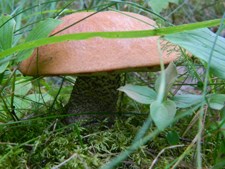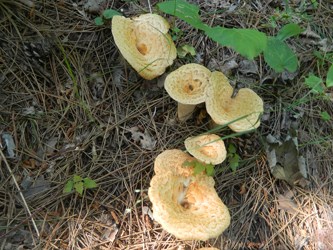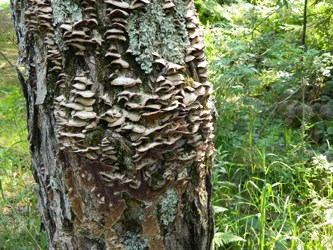
Mushrooms Are Everywhere
All of these are the fruiting bodies of mushrooms and fungi. Everywhere we walk or build or garden, mushrooms can be found. Mushrooms thrive in Voyageurs. Mushrooms are everywhere.
Where Are Mushrooms Found? Suitable habitat for mushrooms can be many places. The landscape in Voyageurs consists of a mixed conifer and deciduous forest, wetlands, lakes, rocky outcrops, bogs, and marshes. This area receives plenty of precipitation, and surface water is abundant. All of these factors produce many different types of mushrooms. There is so much diversity, that the park has an unknown number and variety of mushrooms and fungi. What Do Mushrooms Do? These small but numerous organisms are the original recyclers of nature. Unlike plants that convert sunlight into energy through photosynthesis, mushrooms draw their energy from living or dead material. Often, we see mushrooms on organic material--clumped on dead trees, consuming downed rotten wood, or growing out of animal dung. They slowly decompose this material and return nutrients to the soil, nutrients that help other plants to grow. Without mushrooms, the forest would take considerably longer to decompose and regenerate. Because they help everything recycle, mushrooms thrive almost anywhere in Voyageurs. Mushrooms also help plants grow. Many species have relationships with the trees and wildflowers. Underground, the fungi interact with the plant roots in a way that is beneficial to both organisms.The fungi allow the plant to absorb more water and nutrients from the soil. In turn, the plant provides food in the form of carbohydrates to the fungi. The forests of Voyageurs would not be the same without these fungi.
Mushroom Identification
Mushrooms come in all shapes, sizes, colors, textures, and scents. Some are edible and some are toxic. It is very easy to incorrectly identify a mushroom, and a wrong guess can be a fatal mistake. Here are some common characteristics when identifying wild mushrooms:
Whether we realize it or not, we come in contact with mushrooms every day. The next time you're out on a trail or gathering downed wood for a campfire, look for those mushrooms hiding under leaves, poking out from a tree, or reclaiming a tree stump.
Common Mushrooms in Voyageurs 
Scaly Vase Chanterelle (Gomphus floccosus) Found: Blind Ash Bay, Long Slu Portage Trails 
Turkey Tail (Coriolus sp.) Shelf Polypore Found: Can be found along many of the park trails. 
Lobster Mushroom (Hypomyces lactifluorum) Found: Sullivan Bay, Blind Ash Bay, Beaver Pond, Kab-Ash West & East Trails 
False Morel (Gyromita esculenta) Found: Forest Overlook Trail, Sullivan Bay Trail 
Inky Caps (Coprinus sp.) Found: Echo Bay Trail 
Birch Bolete (Leccinum sp.) Found: Echo Bay Trail |
Last updated: March 6, 2023
